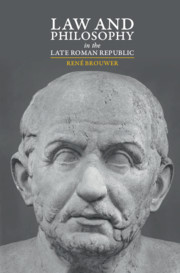Book contents
- Frontmatter
- Table of contents
- Preface
- Chapter 1 Introduction
- Chapter 2 Law and philosophy around 150 bce
- Chapter 3 ‘System’ in law
- Chapter 4 ‘Rule’ in law
- Chapter 5 ‘Person’ in law
- Chapter 6 Casuistry in philosophy
- Chapter 7 Property in philosophy
- Chapter 8 Law and philosophy after 50 bce
- Bibliography
- Index locorum
- General index
Chapter 6 - Casuistry in philosophy
Published online by Cambridge University Press: 29 April 2021
- Frontmatter
- Table of contents
- Preface
- Chapter 1 Introduction
- Chapter 2 Law and philosophy around 150 bce
- Chapter 3 ‘System’ in law
- Chapter 4 ‘Rule’ in law
- Chapter 5 ‘Person’ in law
- Chapter 6 Casuistry in philosophy
- Chapter 7 Property in philosophy
- Chapter 8 Law and philosophy after 50 bce
- Bibliography
- Index locorum
- General index
Summary
Whereas in the previous chapters the influence of law on philosophy is brought up, this chapter deals the influence of law on philosophy, with regard to method. Already within early Hellenistic philosophy a shift of focus can be discerned from a virtue-centered to an action-orientated approach: in the 3rd century BCE the early Stoics had become interested in questions about the ‘appropriate actions’ that can be derived from these virtues. In the 2nd century BCE, inspired by the Roman jurists, the Roman Stoics became interested in the concrete applications of such actions or – put differently – introduced casuistry into philosophy.
- Type
- Chapter
- Information
- Law and Philosophy in the Late Roman Republic , pp. 83 - 102Publisher: Cambridge University PressPrint publication year: 2021

